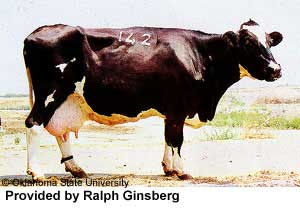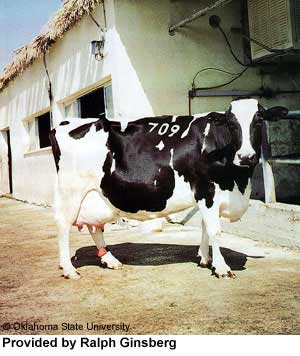Israeli Holstein Cattle
 In Israel's quest for breeding a high-yielding dairy cow adapted to prevailing climatic
conditions, genetic material from the most different sources was brought in, with
the aim of upgrading locally available cattle. Sometimes, imported Dutch bulls were
owned and operated cooperatively. The concerted effort for genetic improvement on
a broader scale began with the onset of artificial insemination in the mid-forties.
The impressive number of Holstein-Friesians imported from the American continent during
the fifties and the strict observance of nation-wide breeding plans contributed decisively
to the creation of the Israeli-Holstein breed.
In Israel's quest for breeding a high-yielding dairy cow adapted to prevailing climatic
conditions, genetic material from the most different sources was brought in, with
the aim of upgrading locally available cattle. Sometimes, imported Dutch bulls were
owned and operated cooperatively. The concerted effort for genetic improvement on
a broader scale began with the onset of artificial insemination in the mid-forties.
The impressive number of Holstein-Friesians imported from the American continent during
the fifties and the strict observance of nation-wide breeding plans contributed decisively
to the creation of the Israeli-Holstein breed.
Modern dairy cattle improvement in Israel started in the early twenties with the importation of Friesian bulls from the Netherlands and Germany to upgrade the indigenous dairy cows of the Damascene and Baladi breeds. In 1947, ten Holstein bulls were imported from Canada and they and their sons were heavily used through artificial insemination. From 1950 through 1962 Holstein bulls and cows were imported from the United States. Since 1963 nearly all Israeli dairy cows have been mated to bulls bred locally.
 The Israeli-Holstein cow was reached with a series of crosses. Israel first took a
Damascus cow and bred it with an imported Dutch bull, thus creating an F1 cross (50%).
The offspring was bred with a different imported Dutch bull, creating an R2 cross
(75%). This R2, when mated with an Israeli-Dutch bull, created an R2 cross (87.5%)
which were bred with other Israeli-Dutch bulls producing later generations of the
cross with higher percentages. These crosses were then bred with the Holstein-Friesian
bulls which resulted in the typical Israeli-Holstein cow.
The Israeli-Holstein cow was reached with a series of crosses. Israel first took a
Damascus cow and bred it with an imported Dutch bull, thus creating an F1 cross (50%).
The offspring was bred with a different imported Dutch bull, creating an R2 cross
(75%). This R2, when mated with an Israeli-Dutch bull, created an R2 cross (87.5%)
which were bred with other Israeli-Dutch bulls producing later generations of the
cross with higher percentages. These crosses were then bred with the Holstein-Friesian
bulls which resulted in the typical Israeli-Holstein cow.
There are currently about 110,000 dairy cows in Israel, practically all of which are Israeli Holstein breed. This number has been virtually constant for the last 20 years. About 60% of all cows are concentrated in Kibbuts herds (large units in cooperatively owned and managed farms), while the remainder belong to Moshev herds (family farms)
References
Mason, I.L. 1996. A World Dictionary of Livestock Breeds, Types and Varieties. Fourth Edition. C.A.B International. 273 pp.
Ralph Ginsberg, Milking Managment Adviser, Israel
